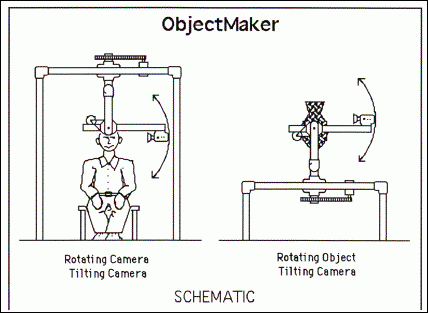QuickTime VR - the beginnings of virtual reality inside Apple

Virtual reality devices and accessories are now very popular. But, like most other devices, the first prototypes were invented at the end of the last century. Years before launching solutions from Oculus or HTC inside Apple, work was underway on the QuickTime Virtual Reality project (abbreviated QuickTime VR).
This project can rightly be considered one of the strangest in the history of Apple. Development began at the time of the work of Steve Jobs in the company NeXT, and Apple then led by John Sculley. At the time of release, QuickTime VR did not work with videos - these were images combined into one panorama to be displayed in 360 degrees. But even that was impressive at the time. If desired, photographers could scan any object in 3D by placing it on a rotating stand and photographing the subject at several angles. Of course, it was not a full-fledged virtual reality, but even now large companies use this term to denote similar content, which is not entirely true.
')

So, a similar mode is in videos on YouTube and a number of other services. But then the panoramic photos made about the same impression as the panoramic video a few years ago. If you can now create a panoramic photo with one click, then in the 90s there were no such solutions, and Apple engineers from the Human Interface Group had a difficult task of merging photos into a coherent picture. As a result, they used the easiest way - panoramas were still shot using a camera in QuickTime VR format, and then they could be viewed on a computer.
“At that time, the process of creating photos was difficult. You needed to take a million photographs in order to later “glue” them together and move between them. I did this with a single camera, as a bunch of several cameras that are used now was too expensive.
But even a simple blend of pictures into a panoramic photo required an absurdly large amount of resources, ” recalls one of the first QuickTime VR engineers and New York University professor Dan O'Sullivan.
If now almost any smartphone on the fly is able to create and process a panoramic picture, then Apple had to buy a Cray supercomputer for this.
Work on QuickTime VR began in 1991, when participants at the Human Interface Lab tried to recreate real objects in 3D. But the successful implementation of some of the division’s projects has opened up a green light for new ones, including QuickTime VR.
“I remember how Sally Ride, who at the time was a member of Apple’s board of directors, could not believe that she could manage 3D objects in real time,” said Sculley to Business Insider.
The QuickTime VR release as a new product took place in 1995, and one of the first panoramas was the view from the Golden Gate Bridge in San Francisco. For this, Apple received permission from the mayor of the city, after which company representatives removed the panorama from the highest point of the bridge. The panorama is still available on the Dan O'Sullivan site .
The demonstration of QuickTime VR at the MacWorld conference caused a real stir, and the project team shot several panoramas in Russia and Paris.
The Case of O.J. Simpson
QuickTime VR received the most attention from the press as part of the case coverage of O. Jay Simpson - the company worked together with NBC representatives. For filming panoramas at a crime scene, the company provided a version of QuickTime VR to journalists even before the official release.
“I knew that the whereabouts of the bodies, traces of blood and other things typical of a murder investigation would be hotly debated. And through one friend at Apple, I learned about working on QuickTime VR. We shot a series of 10 or even 12 places where a trace of blood was found, as well as where, according to rumors, O'J Simpson's car stopped.
Our reporter was able to correctly place all the photos so that you can navigate and view the crime scene. It was very convenient, ”recalls technology consultant and executive news producer at NBC David Bohrman.
VR of that time

It's hard not to draw a parallel between QuickTime VR and existing augmented reality solutions that are used on Facebook, YouTube or even in services such as Google Street View. Most of the existing virtual reality analogues do not meet this definition - for the most part they are panoramic photos or videos, and in this direction Apple developed the first solution.
Sunset QuickTime VR to Apple
After Steve Jobs came to Apple, the QuickTime VR project was no longer considered relevant by the company. The latest QuickTime VR press release came out in 1997, then the company used these developments to create panoramic images of the iPod until 2006, and in the end the project ceased to exist due to obsolete technologies. Now on the market there are much more convenient solutions for scanning and creating panoramic images. It is possible that some developments from QuickTime VR could form the basis of panoramic photos in iOS.
Source: https://habr.com/ru/post/395003/
All Articles